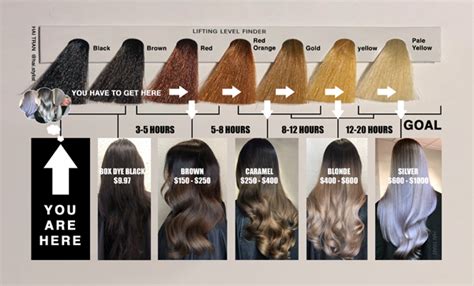Transitioning From Black to Vibrant Hues
Are you ready to transform your dark locks and embrace a world of color? Transitioning from black to shades other than black can seem daunting, but with the right approach, you can achieve stunning results without compromising the health of your hair. Here’s a comprehensive guide to guide you through this exciting journey:

1. Consider Your Skin Tone and Undertones
Your skin tone and undertones play a crucial role in determining which hair colors will complement your features. If you have warm undertones (yellow or peachy hues), warmer shades such as caramel, honey, and copper will harmonize with your skin. Cool undertones (pink or bluish hues) pair well with cooler shades like ash brown, burgundy, and purple.
2. Choose a Gradual Approach
Avoid drastic color changes that could damage your hair. Start with subtle highlights or lowlights to gradually lighten your base color. Over time, you can gradually transition to bolder shades as your hair adjusts to the bleaching process.
3. Professional Bleaching
Bleaching is essential for removing the dark pigments in black hair. However, DIY bleaching can be risky. Trust a professional hairstylist who can assess your hair’s condition and perform the bleaching safely to minimize damage.
4. Toner for Customization
After bleaching, your hair may have unwanted brassy or yellow tones. A toner neutralizes these undertones and creates a desired shade. Toners can also enhance vibrancy and longevity.
5. Moisturize and Protect
Bleached hair requires extra care. Regularly condition your hair to replenish moisture and reduce breakage. Use color-protecting shampoos and conditioners to extend the life of your new hue.
Embracing the Spectrum of Color
Once you’ve transitioned your hair from black, the possibilities are endless. Dive into the captivating world of hair color and embrace shades that reflect your personality and style:
- Subtle Shades: Enhance your natural black color with subtle highlights or lowlights in brown, caramel, or auburn.
- Warm Hues: Embrace warmth with shades like honey, copper, and amber. These colors create a sun-kissed effect and complement warm skin tones.
- Cool Tones: Ash brown, burgundy, and purple add a touch of sophistication and pair well with cool skin tones.
- Bold Brights: Unleash your inner vibrancy with bold shades like blue, green, or pink. These statement colors are perfect for fashion-forward individuals.
- Ombre and Balayage: Create a gradual blend of colors from black to lighter shades. Ombre provides a natural-looking transition, while balayage creates more subtle, painterly highlights.
Health Considerations
While hair color transformations can be exciting, it’s crucial to prioritize hair health. Here are some common pain points and tips to mitigate them:
Pain Point: Hair breakage
Tip: Limit bleaching sessions and use deep-conditioning treatments regularly to strengthen hair strands.
Pain Point: Scalp irritation
Tip: Use gentle shampoos, avoid over-washing, and consider using a scalp serum to soothe irritation.
Pain Point: Color fading
Tip: Invest in color-protecting products and minimize heat styling to preserve your new hue.
Inspiration for Transformation
To spark your imagination, we’ve curated a gallery of stunning hair color transformations from black. From subtle highlights to vibrant hues, these examples showcase the transformative power of color:
[Image of a woman with black hair and subtle brown highlights]
[Image of a woman with black hair and copper balayage]
[Image of a woman with black hair and burgundy ombre]
[Image of a woman with black hair and blue lowlights]
Innovative Applications
Beyond traditional hair coloring techniques, explore innovative applications that push the boundaries of color expression:
- Hair Painting: This technique uses freehand brushstrokes to create multi-dimensional colors and artistic designs.
- Color Melting: Similar to ombre, color melting seamlessly blends multiple shades, resulting in a gradient effect.
- Reverse Balayage: Unlike traditional balayage, reverse balayage lightens the roots and blends them into a darker base color for a unique, edgy look.
Transformative Tables
To simplify your color selection, we’ve created informative tables that outline suitable hair colors based on skin tone and undertones:
| Skin Tone | Warm Undertones | Cool Undertones |
|---|---|---|
| Light | Caramel, Honey, Golden Blonde | Ash Brown, Mahogany, Burgundy |
| Medium | Auburn, Copper, Amber | Chocolate Brown, Lilac, Violet |
| Dark | Espresso, Chestnut, Burgundy | Jet Black, Blue-Black, Raven |
Tips and Tricks for a Seamless Transition
- Start with a consultation: A professional hairstylist can assess your hair and recommend a color transformation plan tailored to your needs.
- Use bleach-free alternatives: If you’re concerned about hair damage, consider ammonia-free or plant-based hair dyes.
- Protect your scalp: Apply a barrier cream around your hairline before bleaching to prevent irritation.
- Deep condition regularly: Replenish moisture and prevent breakage by using deep-conditioning treatments weekly.
- Embrace natural hair care: Avoid heat styling and minimize chemical treatments to maintain healthy hair.
Common Mistakes to Avoid
- Over-Bleaching: Excessive bleaching can weaken your hair, leading to breakage and loss of elasticity.
- Coloring Unhealthy Hair: If your hair is damaged or dry, postpone coloring until you’ve restored its health.
- Neglecting Hair Care: Color-treated hair requires special attention. Regularly condition, moisturize, and protect your hair from environmental stressors.
- Ignoring Root Touch-Ups: As your hair grows, your roots will reveal your natural hair color. Regular touch-ups are essential to maintain the desired shade.
- DIY Mishaps: Hair coloring is a complex process. Trust a professional hairstylist to achieve optimal results and minimize damage.
